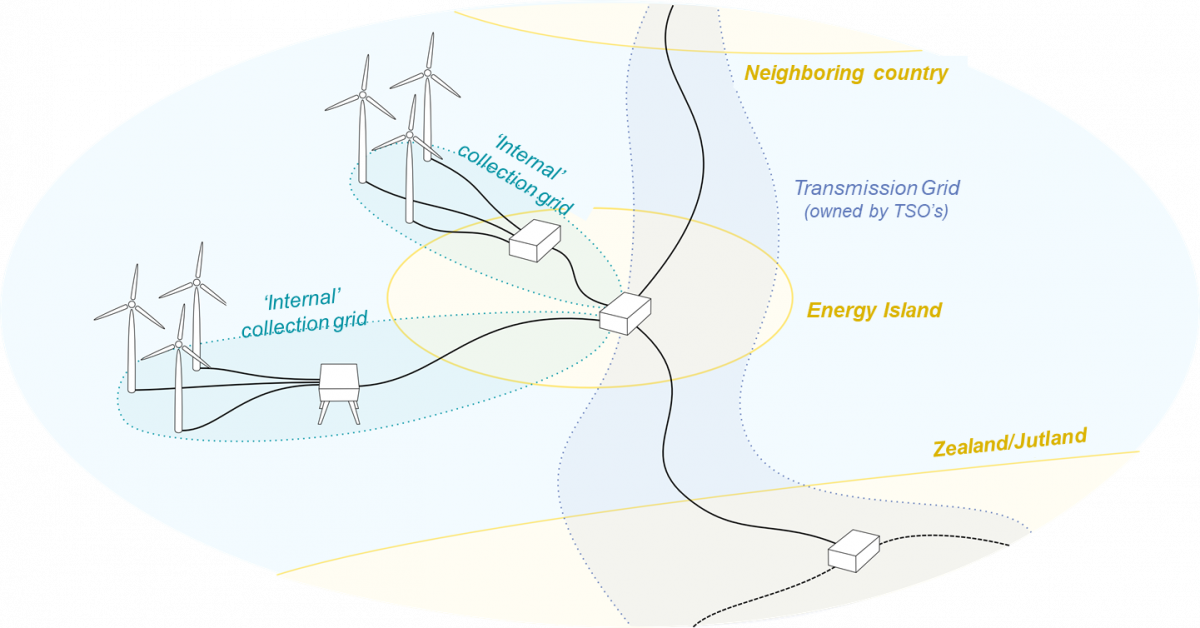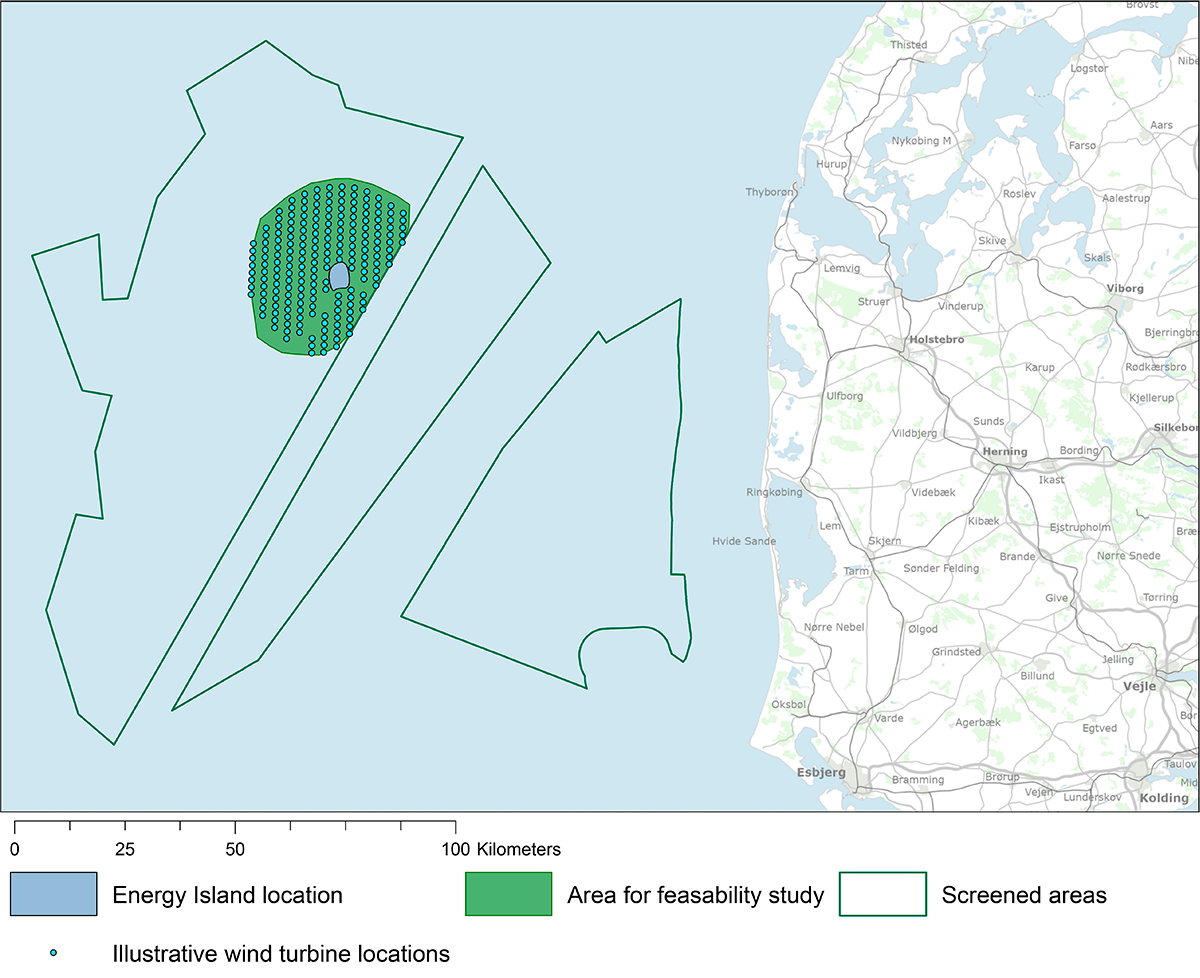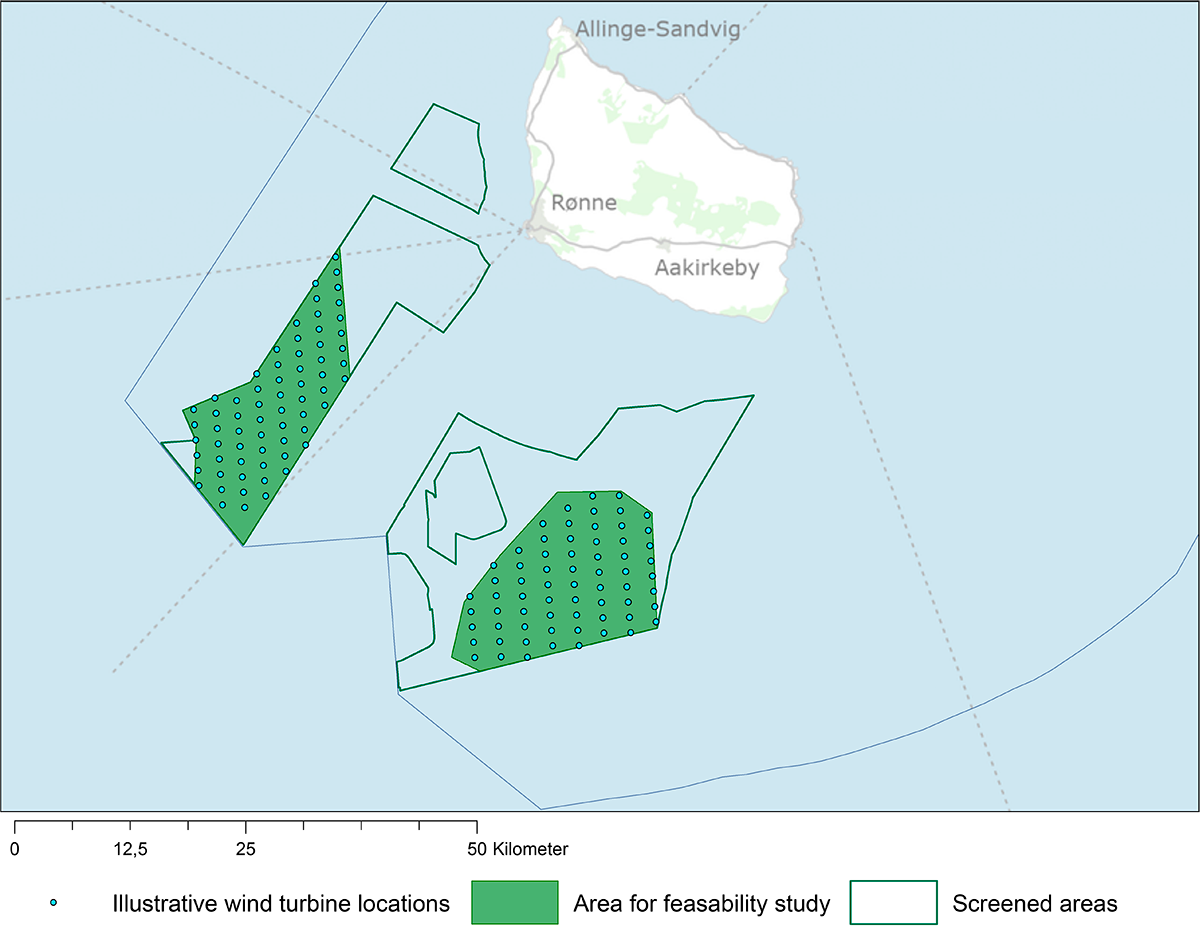The offshore wind turbines around the islands will be able to supply green electricity with a capacity to power at least five million households. The Danish Energy Agency is leading the project and will also be present all the way inside the engine room once the two islands become a reality.
The energy islands mark the beginning of a new era for the generation of energy from offshore wind, aimed at creating a green energy supply for Danish and foreign electricity grids. Operating as green power plants at sea, the islands are expected to play a major role in the phasing-out of fossil fuel energy sources in Denmark and Europe.
- The plan envisages the establishment of an artificial island in the North Sea that will serve as a hub for offshore wind farms supplying 3-4 GW of energy, with a long-term expansion potential of 10 GW.
- The energy island in the Baltic Sea will be Bornholm, where electrotechnical facilities on the island will serve as a hub for offshore wind farms off the coast supplying 3 GW of energy.
Denmark has a long history of exploiting the strong winds from the sea to produce electricity. We constructed the world’s first offshore wind farm in 1991, and in the climate agreement of 22 June 2020, the Danish legislature decided to build on that legacy with the construction of two energy islands. In light of the decision reached by Danish politicians, the Danish Energy Agency is now drawing on domestic expert knowledge as well as extensive experience and skills in this field with a view to taking a historic and ambitious step on the road to phasing out fossil fuels.
After political agreement on the energy islands have been reached, the Danish Energy Agency are playing a key role in leading the project that will transform the two energy islands from a vision to reality. The islands are a pioneer project that will necessitate the deployment of existing knowledge into an entirely new context. Working together with well-established actors in the industry and the highest level of expertise in the field, our goal is to find the best solutions to the aspects of the project that remain unsolved. We are exchanging knowledge, performing quality assurance on solutions and working every day to further the green transition and ensure a reliable supply of electricity to Danish power sockets.
Today, we harness the energy from strong ocean winds via isolated offshore wind farms that supply electricity directly to the Danish electricity grid.
With these energy islands, the wind turbines can be placed further away from the coast and distribute the power they generate between several countries more efficiently. The islands serve as hubs - or green power plants - that gather electricity from the surrounding offshore wind farms and distribute it to the electricity grid in Denmark as well as directly to other countries, giving households and businesses access to this green electricity. This allows electricity from an area with vast wind resources to be more easily routed to areas that need it the most, while also ensuring that the energy generated from the turbines is utilised as efficiently as possible in terms of demand for electricity.
The two energy islands are based on the same concept, where offshore wind farms are connected to electrotechnical facilities on the islands, but they will not be entirely identical. The energy island in the Baltic Sea will be established on Bornholm, which means that the electrotechnical equipment that will allow the collection and distribution of the energy from the offshore wind turbines will be located on land. The island in the North Sea, however, will be an artificial island specifically built for that purpose. This decision to add a new island to the Danish map was reached by the parties to the agreement of 4 February 2021. You can read more about both energy islands further down the page.

Concept diagram of the energy islands collecting electricity from offshore wind farms in the North and Baltic seas (©The Danish Energy Agency)
During the first phase, the offshore wind farms around the Danish energy islands will produce 6-7 GW of electricity; 3-4 GW coming from the North Sea and 3 GW from Bornholm. In the long term, the energy island and offshore wind farms in the North Sea will have their capacity expanded to allow the generation and distribution of 10 GW of electricity.
The island in the North Sea and the surrounding offshore wind farms will be established approximately 100 km off the coast of Thorsminde, a town in Jutland. The island will house electrotechnical facilities for routing electricity from the wind turbines into the electricity grid, and potentially also a harbour and service facilities for the first 3-4 GW of offshore wind farms in the North Sea. Later, the island and wind farms will be expanded to generate and distribute up to 10 GW of electricity as the demand for electricity rises and the islands are ‘plugged in’ to more neighbouring countries.
The wind turbines that will supply power to the island are expected to be larger than current offshore wind turbines, and they will also be established further out at sea than has been attempted before. The turbines will not be visible to the naked eye from land, but if you are flying over the North Sea, you will be able to spot large areas dotted with wind turbines surrounding the island.

Map of areas indicating the location of island and offshore wind in the North Sea. The Danish Energy Agency.
It will be up to the island’s co-owners to decide the exact design and size of the island, which is why information on the specific elements on or around the island, as well as the exact size or specific buildings on the island, is not yet available. The Danish State will enter into a partnership with private sector actors on the ownership of the island, and the framework for procurement and the construction of the island will be determined in an upcoming market dialogue and procurement process. The Danish State will be the majority owner and own at least 50.1 percent of the island. The large amount of electricity sourced from the island will have implications on Denmark’s security of supply. Parts of the electrotechnical facility will therefore constitute critical infrastructure.
The future development of the island
To begin with, the island in the North Sea will have a capacity of 3 GW, corresponding to the electricity consumption of three million households, which is twice the amount of energy that all offshore wind turbines in Denmark combined are capable of generating today. It also corresponds to approximately half of Denmark’s total electricity consumption. The capacity will be expanded in phases to a maximum of 10 GW, which could cover the electricity consumption of 10 million households and contribute to the further electrification of Denmark and its neighbouring countries.
The energy islands are one component of the development of our future energy systems, and the content of the political agreements includes an ambition to transform the electricity from the energy islands into new forms of energy (e.g. Power-to-X). This means that the green power sourced from these energy islands will contribute to the phasing-out of fossil fuels in Denmark and elsewhere in Europe.
Additionally, the goal is for the islands to house equipment that can store surplus electricity when the supply of electricity from the turbines exceeds demand. It is important to emphasise, however, that technologies such as Power-to-X and electricity storage are not yet sufficiently mature to allow us to say with certainty how such technology and equipment can be deployed on the islands. There is enormous potential inherent in the energy islands, and over the course of the project, new solutions will be implemented as the technology behind them is developed. Yet the specific types of technologies the islands will house is something we will only know for certain in the years to come.
In the Baltic Sea, the electrotechnical equipment will be placed on the island of Bornholm, where electricity from offshore wind farms will be routed to electricity grids on Zealand and neighbouring countries. The offshore wind farms will be established approximately 15 km south-southwest of the coast and will be visible to the naked eye, but not dominate the horizon. The turbines off the coast of Bornholm will have a capacity of 3 GW, corresponding to the electricity consumption of two 3,3 million households. As with the North Sea Island, the ambition is for electricity from the offshore wind farms to be converted into other forms of energy, such as Power-to-X. The establishment of Power-to-X must happen on the concessionaire’s initiative.

Location of offshore wind turbines south-southwest of Bornholm, the Baltic Sea energy island. The Danish Energy Agency.
Read and view more about the location of the wind turbines off Bornholm
The work surrounding the energy islands is comprehensive and complex, and there are many processes to complete and decisions to make in parallel. There are therefore many steps that still need to be taken in the project. An overview of the most important steps is laid out below:
- The Danish system operator of the transmission network, Energinet, has been instructed to commence preliminary studies on the seabed around Bornholm and the area in the North Sea where it has been decided the island and offshore wind farms will be located. These preliminary studies are intended to ensure that both the offshore wind farms and the artificial island are placed in areas that are suited for construction and where they will have the least possible impact on the environment. Read the press release (in Danish).
- The Danish Energy Agency is also preparing a procurement for the shared ownership of the island construction in the North Sea. The 5-6 GW of offshore wind farms in the North and Baltic seas will also be put out to tender at a later time.
- Additionally, efforts are underway to sign binding agreements with Denmark’s neighbours to ensure that we can export the green electricity to other European electricity grids than our own.
- Decisions also need to be made regarding where the islands should be connected to land, which includes decisions on where on land to place facilities that enable the safe and stable routing of the electricity out into the Danish electricity grid.
- As is the case for the energy island in the North Sea, the ambition is that power from the offshore wind farms off the coast of Bornholm can be converted into other forms of energy, for example Power-to-X. However, the development of Power-to-X technologies must be initiated by the private winning tenderer for Bornholm Energy Island.
The Danish Energy Agency has enlisted a number of consultants to contribute reports that in various ways relate to the placement of the energy islands and their surrounding offshore wind farms.
The reports have been prepared to identify possible placements ahead of the final decisions on placements. The location for offshore wind parks by Bornholm and the artificial island and offshore wind parks in the North Sea were agreed in a political decision in November 2020 (in Danish).
Energinet has been granted permission to start the preliminary studies on April 28th 2021 (in Danish)
After the political decision of the locations, the TSO Energinet has been instructed to commence preliminary studies on the seabed around Bornholm and the area in the North Sea. At the same time the areas are reserved (in Danish) for the establishment of the energy islands and the governmental development of offshore wind. The preliminary studies are the first steps towards the realization of the energy islands and include geophysical (for example sonar studies where the seabed is screened) and geotechnical studies (for example drilling into the seabed) as well as environmental studies (for example the impact on the area's wildlife).
- Environmental and planning conditions for Bornholm I + II, North Sea II + III and the area west of the North Sea II + III
- Seabed and planning conditions for Bornholm I + II, North Sea II + III and the area west of the North Sea II + III
Annexes - Wind resource, layouts and energy production
- Electrical systems for Bornholm I + II, North Sea II + III and the area west of the North Sea II + III
- Supplement to fine screening of sea areas for the establishment of new offshore wind farms connected to energy island hub
- A geological screening study of potential energy island areas in the Danish North Sea
- Offshore wind turbines off the coast of Bornholm - Visualizations
- Fine screening of sea areas, energy islands
The two energy islands will produce more green energy (wind power) than Denmark need. This means that Denmark will end up with a surplus of electricity, which can exported to our neighbouring countries, contributing to the green transition beyond Denmark’s borders.
Efforts to establish connections to foreign grids are already underway; Denmark has entered into political agreements with several of its neighbours to commence joint analytical efforts to connect the energy islands to their grids.
These agreements will form the basis for cooperation between system operators - meaning Energinet and relevant partners abroad - who will now investigate how these potential connections between the countries and energy islands could be designed. The agreements Denmark has already signed with its neighbours can be found below:
The decision to establish the two energy islands was reached under the climate agreement of 22 June 2020, which was entered into by the Danish Government, the Liberal Party, Danish People’s Party, Social Liberal Party, Socialist People’s Party, the Red-Green Alliance, Conservative Party, Liberal Alliance and the Alternative. Read more about the Climate agreement for energy and industry, etc., of 22 June 2020
In addition to the agreement of 22 June 2020, another agreement was reached between the same parties in February 2021 that the energy island in the North Sea would be built as an artificial island and that the Danish State would be a majority owner of the island in partnership with one or several private sector actors. Read the agreement
This agreement of 1 September 2021 implements parts of the agreement of 4 February and determine important parts of the framework for the specific preparation of the tender for the energy island in the North Sea, including drafting the tender terms regarding the partnership and establishment of the island, as well as the terms and conditions regarding the long-term ownership of and cooperation on the energy island.
- COWI has looked into possible construction types: Cost-benefit analyses - climate footprint, COWI
-
Background report on assumptions and data used in the 2020 cost-benefit analysis (in Danish)
- Press release from the Danish Ministry of Climate, Energy and Utilities (in Danish)
- Energinet (Denmark's TSO)